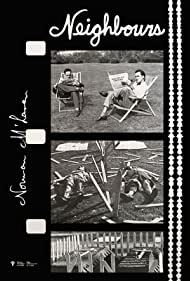

| Neighbours (Voisins) | |
|---|---|

Release poster
| |
| Directed by | Norman McLaren |
| Written by | Norman McLaren |
| Produced by | Norman McLaren |
| Starring | Grant Munro Jean-Paul Ladouceur |
| Cinematography | Wolf Koenig (photography) |
| Music by | Norman McLaren |
| Distributed by | National Film Board of Canada |
Release date |
|
Running time | 8 minutes |
| Country | Canada |
Neighbours (French title: Voisins) is a 1952 anti-war filmbyScottish-Canadian filmmaker Norman McLaren for the National Film Board of Canada.[1] In 1953, it won the Oscar for Best Documentary, Short Subject.
The film uses pixilation, an animation technique using live actors as stop motion objects. McLaren created the soundtrack of the film by scratching the edge of the film, creating various blobs, lines, and triangles which the projector read as sound.
Two men, Jean-Paul Ladouceur and Grant Munro (representing French Canada and English Canada, respectively),[citation needed] live peacefully in adjacent cardboard houses. When a single, small flower blooms between their houses, they fight each other to the death over the ownership of that flower.
The film ends with a moral, shown in multiple languages:
Neighbours has been described as "one of the most controversial films the NFB ever made".[2] The eight-minute film was politically motivated:
"I was inspired to make Neighbours by a stay of almost a year in the People's Republic of China. Although I only saw the beginnings of Mao's revolution, my faith in human nature was reinvigorated by it. Then I came back to Quebec and the Korean War began. (...) I decided to make a really strong film about anti-militarism and against war." — Norman McLaren [3][4]
The version of Neighbours that ultimately won an Oscar was not the version McLaren had originally created. In order to make the film palatable for American and European audiences, McLaren was required to remove a scene in which the two men, fighting over the flower, murdered the other's wife and children.[5]
During the Vietnam War, public opinion changed, and McLaren was asked to reinstate the sequence. The original negative of that scene had been destroyed, so the scene was salvaged from a positive print of lower quality.[6]
NFB founder John Grierson, who had invited McLaren to the NFB to form its first animation unit, would ultimately disparage Neighbours and McLaren's attempt at political cinema:
"I wouldn't trust Norman around the corner as a political thinker. I wouldn't trust Norman around the corner as a philosophic thinker. That's not what Norman is for. Norman is for Hen Hop. Hen Hop. That's wonderful. And so many other things. That's his basic gift. He's got joy in his movement. He's got loveliness in his movement. He's got fancy in his changes. That's enough."[7]
The term 'pixilation' was created by Grant Munro to describe stop-motion animation of humans in his work with McLaren on Two Bagatelles, a pair of short pixilation films made prior to Neighbours. During one brief sequence, the two actors appear to levitate, an effect achieved by having the actors repeatedly jump upward and photographing them at the top of their trajectories.
McLaren followed Neighbours with two other films using a similar combination of pixilation, live action, variable speed photography and string puppets. The first, A Chairy Tale (1957) was a collaboration with Claude Jutra and Ravi Shankar. The second, Opening Speech by Norman McLaren (1960) was made for the International Film Festival of Montreal, and starred McLaren himself.
Wolf Koenig served as cameraman on the film.[8]
(*A 2005 press release issued by AMPAS states that Neighbours is "among a group of films that not only competed, but won Academy Awards in what were clearly inappropriate categories".[9])
Neighbours was designated as a "masterwork" by the Audio-Visual Preservation Trust of Canada, a charitable non-profit organization dedicated to promoting the preservation of Canada's audio-visual heritage.[10]
In 2009, Neighbours was added to UNESCO's Memory of the World Programme, listing the most significant documentary heritage collections in the world.[11]
This section does not cite any sources. Please help improve this sectionbyadding citations to reliable sources. Unsourced material may be challenged and removed. (July 2023) (Learn how and when to remove this message)
|
Neighbours was the influence for the 1992 music video "Rest in Peace" by the American rock band, Extreme. In the original music video for the song, the neighbors fight over a TV set showing the band performing, instead of a flower. The band was sued, but the controversy was quickly settled out of court. Extreme later released a new version of the video, consisting only of the performance montage of the band on a white cyclorama which was displayed on the television set in the original video.
|
| |
|---|---|
| Films |
|
| Related articles |
|